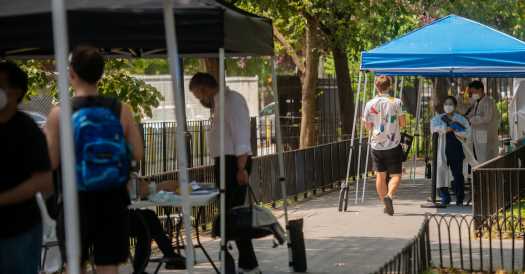The approach, which would require a new emergency authorization, would involve injecting one-fifth of the current dose into the skin instead of a full dose into underlying fat.
Send any friend a story
As a subscriber, you have 10 gift articles to give each month. Anyone can read what you share.
By Sharon LaFraniere and Noah Weiland
WASHINGTON — The Biden administration has decided to stretch out its limited supply of monkeypox vaccine by allowing a different method of injection that uses one-fifth as much per shot, according to people familiar with the discussions.
In order for the Food and Drug Administration to authorize so-called intradermal injection, which would involve injecting one-fifth of the current dose into the skin instead of a full dose into underlying fat, the Department of Health and Human Services will need to issue a new emergency declaration allowing regulators to invoke the F.D.A.’s emergency use powers. That declaration is expected as early as Tuesday afternoon.
The move would help alleviate a shortage of vaccine that has turned into a growing political and public health problem for the administration.
The administration has faced a barrage of criticism that it was too slow to ship vaccine that was ready for use to the United States from Denmark, where it was manufactured, and too slow to order that bulk vaccine stocks be processed into vials after the disease first surfaced here in mid-May.
In less than three months, more than 8,900 monkeypox cases have been reported. The virus can spread from person to person through close physical contact with infectious lesions, by touching items that touched the rash, or via respiratory droplets from coughing or sneezing.
What to Know About the Monkeypox Virus
What is monkeypox? Monkeypox is a virus similar to smallpox, but symptoms are less severe. It was discovered in 1958, after outbreaks occurred in monkeys kept for research. The virus was primarily found in parts of Central and West Africa, but recently it has spread to dozens of countries and infected tens of thousands of people, overwhelmingly men who have sex with men.
What are the symptoms? People who get sick commonly experience a fever, headache, back and muscle aches, swollen lymph nodes, and exhaustion. A few days after getting a fever, most people also develop a rash that starts with flat red marks that become raised and filled with pus. On average, symptoms appear within six to 13 days of exposure, but can take up to three weeks.
How does it spread? The monkeypox virus can spread from person to person through close physical contact with infectious lesions or pustules, by touching items — like clothing or bedding — that previously touched the rash, or via the respiratory droplets produced by coughing or sneezing. Monkeypox can also be transmitted from mother to fetus via the placenta or through close contact during and after birth.
I fear I might have monkeypox. What should I do? There is no way to test for monkeypox if you have only flulike symptoms. But if you start to notice red lesions, you should contact an urgent care center or your primary care physician, who can order a monkeypox test. Isolate at home as soon as you develop symptoms, and wear high-quality masks if you must come in contact with others for medical care.
What is the treatment for monkeypox? If you get sick, the treatment for monkeypox generally involves symptom management. Tecovirimat, a hard-to-obtain antiviral drug also known as TPOXX, occasionally can be used for severe cases. The Jynneos vaccine, which protects against smallpox and monkeypox, can also help reduce symptoms, even if taken after exposure.
Who can get the vaccine? Jynneos vaccine is most commonly used to prevent monkeypox infections, and consists of two doses given four weeks apart. It has mostly been offered to health care workers and people who have had a confirmed or suspected exposure due to limited supplies, though new doses should become available in the coming months. A few states, including New York, have also made vaccines available among higher-risk populations.
I live in New York. Can I get the vaccine? Adult men who have sex with men and who have had multiple sexual partners in the past 14 days are eligible for a vaccine in New York City, as well as close contacts of infected people. Eligible people who have conditions that weaken the immune system or who have a history of dermatitis or eczema are also strongly encouraged to get vaccinated. People can book an appointment through this website.
Even though it invested more than $1 billion in developing the two-dose vaccine known as Jynneos that works against both monkeypox and smallpox, the government has only 1.1 million shots on hand. It needs about three times as many doses to cover the 1.6 million to 1.7 million Americans who, according to the Centers for Disease Control and Prevention, are at high risk of contracting monkeypox.
The vaccine is currently delivered in two 0.5-milliliter doses 28 days apart, with immune protection reaching its “maximum” 14 days after the second dose, according to the C.D.C.
The shot is recommended by the C.D.C. for people who have been exposed to monkeypox and those who might be likely to get it. Those in the latter category include people identified as a contact of someone with monkeypox, those who know a sexual partner from the last 14 days was diagnosed with the disease and those who have had “multiple” sexual partners in that time frame in an area with “known monkeypox.”
Federal health officials said last week that so far, they have distributed about 600,000 doses of the vaccine to state and local jurisdictions.
The Department of Health and Human Services last week also issued a broader public emergency declaration that allowed the federal government to more easily allot money and other resources to fight the virus.
Source: Read Full Article



